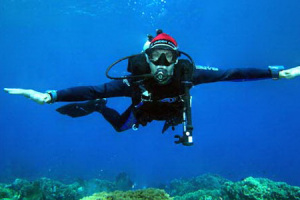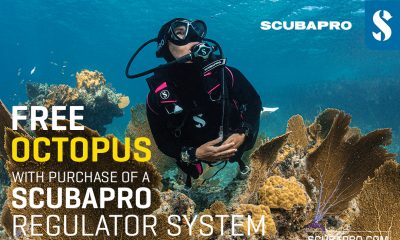News
Buoyancy 101: Do I need some help?

After Sidemount, my favourite course to teach is related to neutral buoyancy and buoyancy control. Why? In my opinion and experience divers gain the most value for money from learning better control of their buoyancy through a one day Advanced Buoyancy class than any other training, gadget or piece of equipment available on the market. I say this because the key benefits of improved buoyancy control are better protection of the marine environment (in case I want to come back and see it again), less physically draining diving and lower ‘Surface Air Consumption (SAC) rates. In simple terms you would probably dive easier and longer for the same money spent on air!
I am constantly reminded when diving of how other divers perceive the concept of trim and neutral buoyancy. Experienced divers I see kicking around or (even worse) lying on the reef as they try to get their next underwater masterpiece, they have the concepts in their head but perhaps are unsure about the execution. Only last month when I was running a small AB class (I call it the ‘Art of Buoyancy’ class), I asked the three students over coffee at the start of the day how they would rate their control underwater. All of them believed they were above average or fairly good. The woman who needed to dive with gloves knew that it was “important to keep off the reef” as she pushes the Gorgonian out of the way with a neoprene covered paw. The gentleman who was completing the course with his daughter claimed he was “very comfortable with keeping off the bottom” as he created a silt storm behind him. The good thing is that these three individuals recognized improving their buoyancy control would improve their diving experience.
The vast majority of divers, like my three students, understand the importance of buoyancy control. Many have not developed the appreciation or have had the opportunity to see or experience buoyancy control concepts in the real world and have not been able to adapt these into their own diving style. So how do you know if you need some help on buoyancy? I’ve listed below a few typical symptoms an signs that your control underwater may not be where you want it and that you may want to think about contacting your local PADI dive center for an AB course:
- Scuffed Fins: Check out the end of your fins. Do they look like they’ve been chewed by the cat for a month? Fins can take a small amount of abuse getting onto or off of the dive boats, but on the whole the fin tips should be fairly even and a recognisable shape. If yours are battered and worn, they have probably come in contact with the reef on a number of occasions.
- High SAC rate: If you had a SAC rate of more than 1 bar per minute (15 psi per minute) and you are usually the first to call ‘low air’ on a dive, and have maybe been referred to as an ‘air hog’.
- Single Kick Style: What is you kick style? Do you only use a flutter kick (up and down movement)? Do you struggle with any other style of kick?
- Hips Down: In candid pictures of your diving from your buddies, are your hips predominately lower than your torso? Get your friends to take some video too and see how you look. Is this how you think you look in the water?
- Handy Man: Do you have a tendency to use your hands for either propulsion or control in the water? We call it sculling, and apart from turning in really tight spaces (usually created by students wanting to see what I am looking at and giving me no room to get out of their way!) it is a really ineffective way of moving in the water. Measure your hand size against a fin and take a guess – which would give you better propulsion if you could control it?
Anyone of these symptoms could suggest that you need to be more aware of your position in the water and your diving style. If your head is bouncing like a nodding dog, then you should come and check me out. Through your Open Water course you’re taught the basic principles of buoyancy control, and many instructors have a different view of the ‘mastery’ requirement. With something like the ‘Art of Buoyancy’ course we’re going to give you the skills to become a master. If you were to take a class like this, your diving would improve. The degree of improvement would depend on how much effort you put in and how much practice you put into each skill, but generally students see marked improvements in their air consumption and are able to enjoy longer dives. They expend less energy on the dive and therefore are less tired during the ‘Après Dive’ sessions.
When I am looking to teach this course, the principal is to use a lot of the skills that you would have learnt in Open Water and try to conduct them in mid-water. This is a principal I was taught when I learned how to dive Sidemount with Fernando Cañada. We would be looking at things like: In confined water conditions can you complete the following skills and still maintain your position?
- Blind hover – Get yourself into a hover in about 2m of water. Close your eyes and hold your position for 20, 30 and 60 seconds.
- Mask remove and replace – Get yourself into a hover in about 2m of water. Remove your mask and hold it off for about 5 breaths before replacing it
- BCD remove and replace – Get yourself into a hover in about 2m of water. Remove your BCD fully and put it back on again.
If you would like to find out more about improving your buoyancy, completing the ‘Art of Buoyancy’ program or learning to dive in the amazing Caribbean Sea off Carriacou, visit www.deeferdiving.com.
Blogs
The Ocean Cleanup Breaks 10,000,000 KG Barrier

The Ocean Cleanup, the global non-profit project, has removed a verified all-time total of ten million kilograms (22 million lbs.) of trash from oceans and rivers around the world – approximately the same weight as the Eiffel Tower.
To complete its mission of ridding the oceans of plastic, The Ocean Cleanup uses a dual strategy: cleaning up the Great Pacific Garbage Patch (GPGP) to remove the plastic already afloat in the oceans, while stopping the flow of plastic from the world’s most polluting rivers.
Through cleaning operations in the GPGP and in rivers in eight countries, the cumulative total of trash removed has now surpassed ten million kilograms. This milestone demonstrates the acceleration of The Ocean Cleanup’s impact, while underlining the astonishing scale of the plastic pollution problem and the need for continued support and action.
While encouraging for the mission, this milestone is only a staging point: millions more tons of plastic still pollute our oceans and The Ocean Cleanup intends to continue learning, improving and innovating to solve this global catastrophe.
This announcement comes as governments from around the world meet to continue negotiations to develop a new legally binding instrument to end plastic pollution at INC4 in Ottawa, Canada. Representatives of The Ocean Cleanup will be in attendance and the organization will be urging decision-makers to collaborate towards a comprehensive and ambitious global treaty which addresses plastic at all stages of its life cycle and in all marine environments worldwide, including in areas beyond national jurisdiction.
It is encouraging to see that the need for remediation is reflected in the various options for potential treaty provisions. It is essential that the final treaty contains clear targets for the remediation of legacy plastic pollution, and reduction of riverine plastic emissions.
Tackling plastic pollution requires innovative and impactful solutions. The treaty should therefore incentivize the innovation ecosystem by fostering innovations that make maximal use of data, technology and scientific knowledge – such as those designed and deployed by The Ocean Cleanup.
‘After many tough years of trial and error, it’s amazing to see our work is starting to pay off – and I am proud of the team who has brought us to this point.’ said Boyan Slat, Founder and CEO of The Ocean Cleanup. ‘While we still have a long way to go, our recent successes fill us with renewed confidence that the oceans can be cleaned.’
The Ocean Cleanup was founded in 2013 and captured its first plastic in 2019, with the first confirmed catch in the GPGP coming soon after the deployment of Interceptor 001 in Jakarta, Indonesia. After surpassing one million kilograms of trash removed in early 2022, the non-profit project has since progressed to the third iteration of its GPGP cleaning solution, known as System 03, and a network of Interceptors currently covering rivers in eight countries, with more deployments set for 2024.
About The Ocean Cleanup
The Ocean Cleanup is an international non-profit organization that develops and scales technologies to rid the world’s oceans of plastic. They aim to achieve this goal through a dual strategy: stemming the inflow via rivers and cleaning up the legacy plastic that has already accumulated in the ocean. For the latter, The Ocean Cleanup develops large-scale systems to efficiently concentrate the plastic for periodic removal. This plastic is tracked and traced through DNV’s chain of custody model to certify claims of origin when recycling it into new products. To curb the tide via rivers, The Ocean Cleanup has developed Interceptor™ solutions to halt and extract riverine plastic before it reaches the ocean. Founded in 2013 by Boyan Slat, The Ocean Cleanup now employs a broadly multi-disciplined team of approximately 140. The foundation is headquartered in Rotterdam, the Netherlands.
For more information, visit: theoceancleanup.com and follow @theoceancleanup on social media.
Marine Life & Conservation
Steve Backshall to headline Shark Trust’s flagship event: For the Love of Sharks

Join a host of amazing, shark loving, speakers including Steve Backshall and the Shark Trust team for an evening celebrating shark conservation at the Royal Geographical Society in London this November.
Date: 29th November 2024
Time: 6-10pm
Location: Royal Geographical Society, London
Tickets: https://www.sharktrust.org/Event/flos24
The event will be a celebration of all things shark. Those lucky enough to get hold of tickets will hear from engaging guest speakers with a passion for sharks.
The line-up includes (*subject to change if unforeseen circumstances arise)
Steve Backshall: One of television’s busiest presenters, BAFTA award-winning wildlife expert Steve has been passionate about the wild world ever since he was young.
Steve’s impressive TV career has taken him all around the world, investigating a wide array of species and environments. Steve has filmed over 100 hours of children’s wildlife programmes with the BAFTA award winning Deadly 60 franchise and recently, with Sky Nature, for his new series ‘Whale with Steve Backshall’. He has been a patron for the Shark Trust for 10 years.
Simon Rogerson: is a photojournalist specialising in natural history, diving and the sea.
He is editor of SCUBA magazine, the official journal of the British Sub-Aqua Club. Simon started his career as a crime reporter but gravitated towards his ‘less depressing’ interest in underwater exploration, joining the staff of DIVE magazine in 1999. In 2005 he was named ‘Editor of the Year’ in the PPA’s Independent Publishing Awards. Simon also works as a freelance writer, contributing frequently to the Sunday Times and Telegraph, in addition to BBC Wildlife, Esquire, and a host of international diving magazines. He is the author of a book, Dive Red Sea, published by Ultimate Sports. Now based in Berkshire, Simon has been a Patron of the Shark Trust for 20 years.
More speakers to be announced soon. Head to the Shark Trust website to learn more.
The evening will also allow guests the final chance to see the Oceanic 31, shark art exhibition. Some of the artwork will be auctioned/raffled at the event, while the rest will be auctioned online to raise money for the Shark Trust Oceanic Programme.
For the Love of Sharks is an evening with something for everyone who is interested and fascinated by sharks. Join the Shark Trust, their Patrons, Trustees and Staff, along with a host of supporters for this celebration of shark conservation.
For more information or to buy a ticket: https://www.sharktrust.org/Event/flos24
-

 News3 months ago
News3 months agoHone your underwater photography skills with Alphamarine Photography at Red Sea Diving Safari in March
-

 News3 months ago
News3 months agoCapturing Critters in Lembeh Underwater Photography Workshop 2024: Event Roundup
-

 Marine Life & Conservation Blogs3 months ago
Marine Life & Conservation Blogs3 months agoCreature Feature: Swell Sharks
-

 Blogs2 months ago
Blogs2 months agoMurex Resorts: Passport to Paradise!
-

 Blogs2 months ago
Blogs2 months agoDiver Discovering Whale Skeletons Beneath Ice Judged World’s Best Underwater Photograph
-

 Gear Reviews3 weeks ago
Gear Reviews3 weeks agoGEAR REVIEW – Revolutionising Diving Comfort: The Sharkskin T2 Chillproof Suit
-

 Gear Reviews3 months ago
Gear Reviews3 months agoGear Review: Oceanic+ Dive Housing for iPhone
-

 Marine Life & Conservation2 months ago
Marine Life & Conservation2 months agoSave the Manatee Club launches brand new webcams at Silver Springs State Park, Florida

















